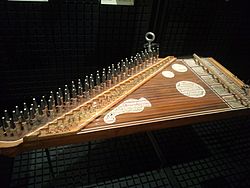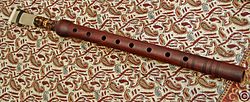Kurdish musical instruments
| Music of Kurdistan | ||||||
| General topics | ||||||
|---|---|---|---|---|---|---|
| Genres | ||||||
| Specific forms | ||||||
|
||||||
| Media and performance | ||||||
|
||||||
| Nationalistic and patriotic songs | ||||||
|
||||||
Kurdish musical instruments (Kurdish: ئامێرە میوزیکییە کوردییەکان, romanized: Amêre mîwzîkiye Kurdiyekan) are traditional instruments used in the music of the Kurdish people, in Kurdistan, which spans parts of modern-day Turkey, Iraq, Iran, Syria, and Armenia. These instruments are integral to Kurdish cultural expression and are commonly used in folk music and ceremonial performances.[1] The musical tradition features a variety of wind, string, and percussion instruments, many of which are unique to the region or adapted from neighboring cultures. Kurdish instruments often accompany dance,[2] poetry, and storytelling, reflecting the oral and musical heritage of the Kurdish people.[3][4]
Among the most prominent Kurdish musical instruments are the tembûr, kemenche, and daf,[5] which are commonly played during cultural celebrations such as Newroz, weddings, and other traditional gatherings.[6][7]
The geography of Kurdistan influences the variety of musical instruments and styles, with different regions and communities maintaining distinct traditions that reflect their local environments. For example, music from mountainous areas often features specific rhythms and storytelling elements, while melodies from the plains tend to be smoother.[8]
Religious use
[edit]
The tanbur is used in the spiritual and religious practices of some Kurdish communities, particularly within Yarsanism. In Yarsan ceremonies, it functions as the main melodic instrument during zikr (ritual remembrance), where it is regarded by practitioners as having sacred associations.[9][10][11] It is believed to convey spiritual meaning and is sometimes interpreted as a medium for divine communication or the metaphysical concept of creation.[12]
The instrument is also associated with Kurdish folklore and the mountainous regions of Kurdistan. During the period of Shah Khoshin, the tanbur held a notable place in Yarsan religious expression, serving both ritual and cultural functions.[13][14][15]
Types of Kurdish musical instruments
[edit]String Instruments
[edit]| Name in English | Name in Kurdish | Description | Picture |
|---|---|---|---|
| Tanbur | Tembûr\Tenbûr تەمبوور/تەنبوور |
A long-necked lute used widely in Kurdish music, known for its deep, resonant sound.[16][17] |  |
| Kamancheh | Kemançe کەمانچە |
A bowed string instrument similar to a fiddle, played vertically. |  |
| Oud . | 'Oûd عوود |
A pear-shaped, fretless lute common in Middle Eastern music, with a rich tonal range.[18] |  |
| Santoor | Sentûr سەنتوور |
A hammered dulcimer with multiple strings, played with small mallets. |  |
| Buzuq | Buzûq بوزووق |
A long-necked fretted lute with a bright and sharp tone. | |
| Rebab | Řebabe ڕەبابە |
A traditional bowed string instrument with a small body, common in Kurdish and Middle Eastern music. |  |
| Tar | Tar تار |
A double-bowl long-necked lute with a skin-covered resonator; It is known for its deep, rich tone. |  |
| Qanun | Qanûn قانوون |
A trapezoidal zither with many strings, plucked to produce intricate melodies. |  |
| Bağlama | Saz ساز |
A long-necked stringed lute used widely in Kurdish and Middle Eastern music, known for its bright and resonant sound.[19][20] |  |
| Dutar | Dûtar دووتار |
A long-necked two-stringed lute with a pear-shaped body, typically plucked by fingers. It produces a soft, melodic tone and is used in various traditional music styles. |  |
| Setar | Sêtar سێتار |
A delicate, long-necked lute with four metal strings, played with the fingernail. |  |
Wind Instruments
[edit]| Name in English | Name in Kurdish | Description | Picture |
|---|---|---|---|
| Zurna | Zûřna زووڕنا |
A loud double-reed wind instrument, often played at celebrations.[21] |  |
| Flute (Shepherd's flute) | Bilwêr بلوێر[a] |
A small wooden flute with a sweet, melodic tone.[22] |  |
| Balaban | Balleban باڵەبان |
A cylindrical double-reed wind instrument with a soft, mournful tone. It is often played in folk ensembles and ceremonies.[18] |  |
| Ney | Ney نەی[b] |
An end-blown flute made of hollow reed. It produces a breathy, spiritual tone and is associated with classical and mystic traditions.[23] |  |
Percussion Instruments
[edit]| Name in English | Name in Kurdish | Description | Picture |
|---|---|---|---|
| Davul | Deholl دەھۆڵ |
A large cylindrical drum played with sticks or hands, producing deep sounds.[24] |  |
| Daf | Def دەف |
A large frame drum with metal rings, used in spiritual and folk music.[25] |  |
| Goblet drum and Tombak | Dûmbek دومبەک |
A goblet-shaped drum played with fingers and palms, common in Kurdish music.[25] |  |
| Nagara | Neqare نەقارە |
A kettle drum producing strong rhythmic beats, often used in folk ensembles. |  |
See also
[edit]- Ziryab
- Mojtaba Mirzadeh
- Middle Eastern music
- National symbols of the Kurds
- List of musical instruments
Notes
[edit]References
[edit]- ^ Shiloah, Amnon (2001). "Kurdish music". In Sadie, Stanley; Tyrrell, John (eds.). The New Grove Dictionary of Music and Musicians. Vol. xiv (2nd ed.). London: Macmillan. p. 40.
- ^ Garland Encyclopedia 2013, p. 857.
- ^ "An Introduction to Kurdish Folk Music". FolkWorks. Retrieved 2025-06-04.
- ^ "Kurdish music and instruments". Kurdishglobe. 2024-08-26. Retrieved 2025-06-04.
- ^ LoBaido, Anthony C.; Ng, Yumi; Rozario, Paul (2003-01-01). The Kurds of Asia. Lerner Publications. ISBN 978-0-8225-0664-5.
- ^ "An Introduction to Kurdish Folk Music". FolkWorks. Retrieved 2025-06-04.
- ^ "Kurdish music and instruments". Kurdishglobe. 2024-08-26. Retrieved 2025-06-04.
- ^ Nezan, Kendal. "Kurdish music: Musical Genres". Kurdish Institute of Paris. Retrieved 2025-06-04.
- ^ Kakeyi, Ali (2020). An Ethnomusicological Approach to Kurdish Music and Its Role in the Kurdish Nation-State Project (PhD). Kent State University. Retrieved 4 June 2025.
- ^ "The Tanbur Society". www.tanbursociety.com. Retrieved 2025-06-05.
- ^ Mohammedi, Hesam. "Tanbur instrument". Safa Music. Retrieved 2025-06-05.
- ^ "What do you know about the tanbur instrument?". SaedNews. 2025-05-04. Retrieved 2025-06-05.
- ^ Scheherezade Qassim Hassan; Morris, R. Conway; Baily, John; During, Jean (2001). "Tanbur". In Sadie, Stanley; Tyrrell, John (eds.). The New Grove Dictionary of Music and Musicians. Vol. xxv (2nd ed.). London: Macmillan. pp. 61–62.
- ^ "Tanbur, the sound of truth". bazarkurdistan.com. 2024-12-26. Retrieved 2025-06-05.
- ^ Mehrpouyan, Azadeh (2016-01-01). "Tanbur as Stringed Music Instrument: Role, Qualities, Influences on Yarsanism". IJASOS- International E-journal of Advances in Social Sciences. doi:10.18769/IJASOS.11132.
- ^ Fozi, Navid (2007). "The Hallowed Summoning of Tradition: Body Techniques in Construction of the Sacred Tanbur of Western Iran". Anthropological Quarterly. 80 (1): 173–205. ISSN 0003-5491.
- ^ "تنبور (یا تمبور/ طنبور)". Encyclopaedia Islamica. Archived from the original on June 23, 2013.
- ^ a b Gelletly, LeeAnne (2014-11-17). The Kurds. Simon and Schuster. ISBN 978-1-63355-946-2.
- ^ Hamelink, Wendelmoet (2016-04-08). The Sung Home. Narrative, Morality, and the Kurdish Nation. BRILL. p. 62. ISBN 978-90-04-31482-5.
- ^ Garland Encyclopedia 2013, p. 778.
- ^ Garland Encyclopedia 2013, p. 860.
- ^ Broughton, Ellingham, Trillo, Simon, Mark, Richard (1999). World music: the rough guide. Africa, Europe and the Middle East, Volum 1. p. 379. ISBN 9781858286358.
{{cite book}}: CS1 maint: multiple names: authors list (link) - ^ Garland Encyclopedia 2013, p. 858.
- ^ "On the Trails of a Banned Language". The Attic. Retrieved 2025-06-05.
- ^ a b Ayliffe, Rosie (2003). The Rough Guide to Turkey. Rough Guides. p. 1028. ISBN 978-1-84353-071-8.
Sources
[edit]- Garland Encyclopedia, World Music (2013-02-01). The Concise Garland Encyclopedia of World Music, Volume 2. Routledge. ISBN 978-1-136-09602-0.
Further reading
[edit]- Dzhagatspanyan, K. A. (1986). Azatovna, Karine (ed.). Ritm natsional’noy rechi i muzyki (Ритм национальной речи и музыки) [The rhythm of national speech and music] (in Russian). Armenia: Sovetakan grokh.
- Rostami, Mari R. (2019-06-27). Kurdish Nationalism on Stage: Performance, Politics and Resistance in Iraq. Bloomsbury Publishing. ISBN 978-1-78831-869-3.
External links
[edit]- Introduction of Kurdish musical instruments – Silêmanî, Kurdistan region

